A Bully Behind Glass: Finding John Harrison’s Clock, Part 2
The continuing saga of how I made it to see John Harrison’s clock. Don’t forget to read Part 1.
In the past, I’ve gotten very stressed out while traveling, particularly when things don’t go as planned. Since starting the blog, though, I’ve found that even the mishaps are worthwhile. Though it’s completely contrary to my prepare-for-anything Type-A personality, I actually find myself to be the sort of person who sits back and laughs when things go awry, thinking, “Well, at least this will make a great blog post.”
Or so I like to tell myself. In truth, there’s still a little voice in the back of my head screaming, “YOU ARE GOING TO GET KILLED BECAUSE YOU HAVE NO IDEA WHERE YOU ARE GOING!” (okay, so maybe it’s not so little a voice). But I can’t very well listen to it, because if I did, I would just sit in my hotel room panicking all the time. So I blindly head out, determined to explore a city, and not let anything hold me back.
This occassionally backfires. The morning that I decided to go see Harrison’s clocks, I may have neglected to actually look up where it was. Someone told me to go to North Greenwich, so I hopped on a tube from Tottenham Station. I transfered at Waterloo, and took a second tube to North Greenwich, feeling rather proud of myself.
It was a bit premature, of course. I got off the train at North Greenwich and looked at a map posted up in the station. It was at that moment that I realized Greenwich and North Greenwich are two distinct places. And that Harrison’s clock was not in North Greenwich. And while I knew specifically where the clock was not, I could not definitively say where it was. Was I just going to take another train to Greenwich and assume I’d figure it out?

Of course I was.
I hopped back on the train heading northbound, and got off a stop called Canary Wharf, where I would need to catch the DLR (Dockland’s Light Railway). Supposedly that would take me to Greenwich and Harrison’s clock. I found that the stop at Canary Wharf was in the middle of a corporate area. It’s funny, but there’s nothing so distressing to me as a business park in a city I am unfamiliar with. I don’t know why … I suppose it’s that wherever I go in the world, business parks remind me that life isn’t one big vacation. That there are times when you’ve got to sit at a desk in a miserable job and feel lonely.
I walked through Canary Wharf to the DLR stop. It was cold and quiet, and there wasn’t a soul in sight. I considered hopping on the train and going back to the hotel – this was ridiculous. All this work to see a clock written about in a book I didn’t like. But then I thought about my dad, and Rand, and about my younger self, trudging through the book and complaining to Laura that it was the worst thing ever written.
You know when you’re a kid, and you’re about to go swimming but the water is way, way too cold? So you creep in slowly, until the water hits your bathing suit, and at that point you just have to dive right in? Well, at Canary Wharf, I realized the water had hit my bathing suit. There was no way in hell I wasn’t going to see Harrison’s clock. So I dove right in.
I got on the DLR and kept going. I kept going when the train I was on abruptly stopped and we all had to get off and wait for yet another train to take us to the exact same place the first train was heading. And when I stepped out off the platform in Cutty Sark, and realized I had no idea which direction to go, I kept going. And when I realized I was absolutely starving and couldn’t take another step, well … well, then I got a snack.

I'm determined. Not stupid.
And after that snack? I kept going. I followed the signs for the Maritime Museum, until I came to its front entrance.
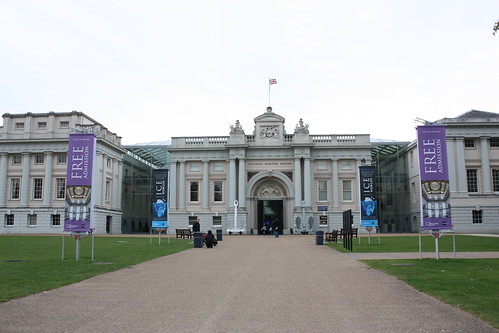
I just stood outside for a while, staring at the building. It had taken me 2 hours and 5 trains to get there. And it had taken me 12 years to realize I wanted to go there. The damn clock. I was finally going to see the Harrison’s damn clock. I walked up to the woman sitting at the front desk and tried to conceal any signs of neurosis or excitement.
“Excuse me,” I said, steadying my voice. “Can you tell me where I can find John Harrison’s clock?”
“Oh, that’s not here.”
Even as I type that, I have to laugh. Of course the clock wasn’t there. In that moment, I realized one of two things was going to come from this situation: either a really good story, or an aneurysm.
I sincerely hoped it was the former, but at this point, I’d take what I could get. The woman at the desk explained that the clock was actually at the Royal Observatory, just up the hill (the two share a website on which they seem indistinguishable, and I was viewing all of this on my crappy phone – so my confusion seemed understandable). I decided to walk around the National Maritime Museum – after all, I was there and admission was free. You know how I feel about free admission.
(In retrospect, I probably shouldn’t have dallied – I could easily have seen this story ending me with me finally arriving at the Royal Observatory, only to find it had closed. Fortunately, this wasn’t the case. Instead, despite all the mishaps and missed connections, it seemed that the fates were lining things up so that I arrived at the Royal Observatory at exactly the right time.)
The National Maritime Museum is in a beautiful building, and while the significance of some of the antiquities located therein was lost on me (I didn’t fully understand the history of bullet-hole-ridden jacket), there was a lot to see. There were a few items on loan from a salvage expedition of the Titanic (including a pocket watch that had stopped at precisely the time it had hit the water), and numerous figureheads from old British warships.
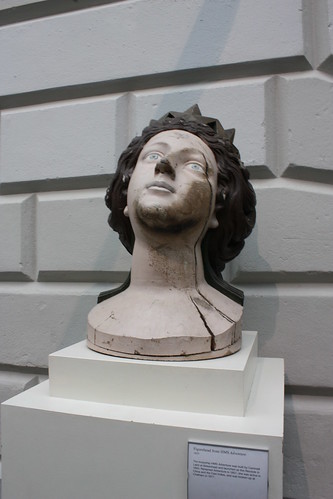
But they weren’t Harrison’s clock. Realizing that I might miss out on it all together (because in addition to not looking up directions, I had also neglected to find out what hours it was open), I headed out to find the Royal Observatory. It was perched on a hill that didn’t look terribly steep, but that proved misleading.
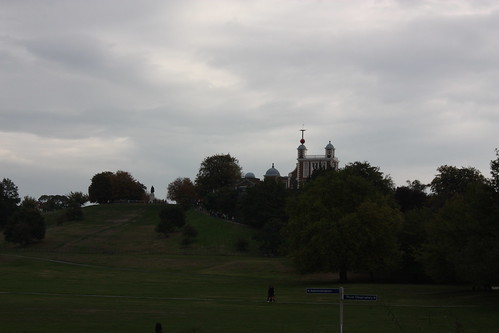
It was a trek. By the time I reached the top, sweaty and tired, I had begun to question my sanity. All this for a clock? But as usual, things have a way of working out, sometimes perfectly. I reached the observatory, just as a tour (the only one of the day) was beginning. The guide told us all about Harrison and Edmund Halley, and George III. She walked us through the entire observatory and gave us the background behind Parliament’s Longitude Act. And she ended with Harrison’s clocks, and how he finally won the 20,000 pounds.
And even though I wasn’t supposed to, and may have gotten into a *weensy* bit of trouble for it, I snuck in some photos. Which aren’t great, obviously, but I couldn’t have gone all that way without some proof of having been there.
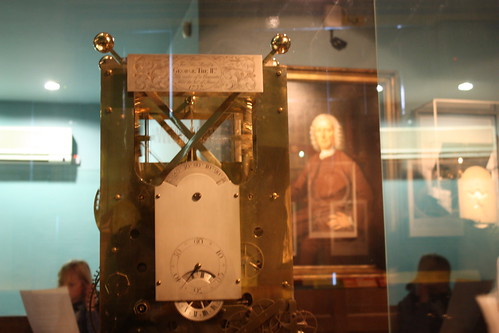
This was one of Harrison's earlier clocks, with his portrait in the background.
And of course, Harrison’s last clock, the prize-winning H4, the reason for all this madness, was there. It was small – smaller than a dinner plate – and rather unassuming. It looked like a huge pocketwatch.
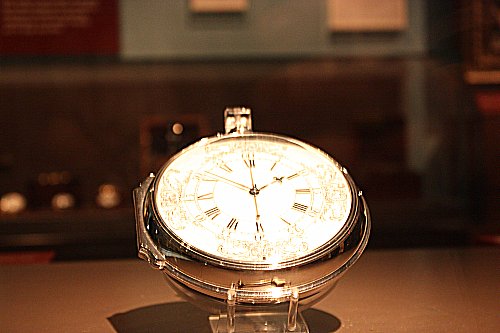
Hello, Meshie.
I had hoped for closure upon finding the clock – that I’d suddenly get a sense of perspective about things and the book, my hatred of it, and maybe even high school would make a little more sense. And the craziest thing was, it all did. Because the second I saw those damn clocks, and the portrait of Harrison in the background, quietly guarding them, I couldn’t help but smile. It took more than a decade, but we had managed to become friends.
I was a bit sad to say good-bye to them, but it was getting late (and the security guards were on to me). I walked around the outside of the observatory for a bit, snapped a few photos of the prime meridian, and left.
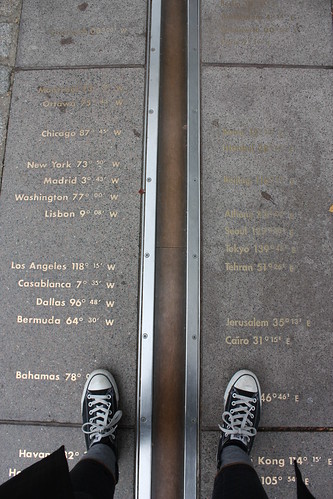
This photo is entitled "Prime Meridian and Converse."
On the tube ride back, I got to thinking about John Harrison, and how he had made four clocks over 40 years before creating one he was truly satisfied with. I thought about how took me 12 years to appreciate his life’s work, and about my trek to Greenwich to finally see his opus.
And I figure we’re even now.









Leave a Comment